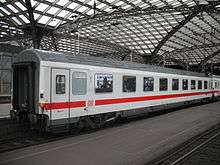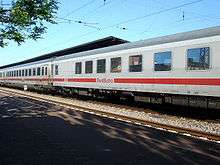UIC classification of railway coaches
Railway coaches are classified under an international system developed by the UIC. This UIC classification of railway coaches replaced earlier national classification schemes in many countries, such as Germany. The coach class is expressed as a combination of letters. It is sometimes followed, for example in the Deutsche Bahn AG, by a three-figure class number. In a broader sense the vehicle number displayed on the coach is also part of its classification, because it encodes other technical details such as the top speed or the type of heating system used.
For example the full designation of a passenger coach, including its coach number, looks like this:
73 80 29-94 708-7 Bpmbz 293.6
This article explains how this classification code on the sole bar of each coach may be decoded.
Main letters




The classification of a coach begins with one or more class letters, in our example above, a capital B. It describes the general class of coach:
| A | Passenger coach with 1st class seating | |
| B | Passenger coach with 2nd class seating | |
| AB | Composite coach with 1st and 2nd class seating | |
| AR | Coach with 1st class seating, kitchen and dining area | |
| BC | Coach with 2nd class seating and place for disabled, and could also include playroom for children | (Norway only) |
| BF | Coach with place for small children, place for disabled, staff room and bicycle room | (Norway only) |
| BR | Coach with 2nd class seating, kitchen and dining area | |
| AD, BD | Composite coach with 1st or 2nd class seating and a luggage compartment | |
| D | Luggage van | |
| DA, DB | Double-decker coach with 1st and 2nd class | (Germany only) |
| DD | Double-decker luggage van | (DR only) |
| DD | Double-decker car transporter of the passenger coach type | (used in motorail trains) |
| Post | Mail van | (Germany only) |
| F | Luggage van | (Norway and Sweden only) |
| F | Mail van | (Austria only) |
| FR | Coach with restaurant / bistro and staff room / luggage room | (Norway only) |
| BPost | Composite coach with 2nd class and a mail section | |
| DPost | Luggage van with a mail section | |
| WG | Club car | (Germany only) |
| WGS | Special club car (Saloon car) | (Germany only) |
| SR | Club car | |
| Salon | Saloon coach | |
| WR | Restaurant car | |
| WL… | Sleeper | (only in combination with A or B) |
| K… | Narrow gauge coach | (only in combination with A, B or D) |
| Z | Mail van | (Switzerland only) |
| Z | Prisoner transporter | (DR only) |
Secondary letters (Deutsche Bahn AG)
The following lower-case letters follow the main letters and describe the technical equipment and fittings of the coach. How the letters are used, is at least partly up to the individual railway company. This overview is based on the system used by the Deutsche Bahn AG:
| m | Passenger coach with a length of more than 24.5 metres, rubber, gangway connectors (except on DDm) |
| l | As m, but without a corridor (currently not in use) |
| n | Local train passenger coach (Nahverkehrswagen) with a length of more than 24.5 metres, open coach with centre aisle in 2nd class (12 notional compartments), centre aisle or side corridor in 1st class, two centre doors, suitable for push-pull operations (36-pole control cable) |
| y | Local train passenger coach with a length of more than 24.5 m, open coach with centre aisle in 2nd class (11 notional compartments), two centre doors, suitable for push-pull operations (34-pole control cable) |
| x | S-Bahn open coach with centre doors, bus bar for current collection, centre doors and high performance brake see also: x coach) |
| p | Open coach with centre doors (pullman type), air-conditioned |
| v | Long-distance coach with fewer (verringerter) compartments (11 instead of 12 on Bm and 9 instead of 10 on Am coaches,6/4 instead of 6/5 on ABm coaches) |
| o | in addition to m: fewer compartments and without (ohne) air-conditioning |
| i | in addition to m: former InterRegio coach |
| formerly: coach with gangway, but no bellows or rubber connectors | |
| c | Coach with compartments, in which the seats can be converted to couchettes ("couchette coach") |
| d | Coach with multi-purpose or bicycle section |
| k | Coach with bistro/kiosk or kitchen section or snack machines |
| a | Coach equipped with automatic door operation (TAV). |
| r | Coach with high-performance brake (Rapid-Bremse) KE-GPR. Only used in combination with n or on mail vans. |
| s | on luggage vans: corridor (Seitengang) |
| on sleepers: Special type (small single- or twin-bed compartments) | |
| b | Coach with equipment for the disabled (behindertengerechte) |
| formerly: coach mit command-control cabling (Befehls-Leitung) | |
| h | Coach which has both a bus-bar and can supply current from its own axle generators |
| also: non-converted local passenger train coaches of Reichsbahn origin | |
| z | Coach with power supply from the bus-bar (no axle generators) |
| u | Coach with 34-pole push-pull control cabling (DR type) |
| uu | Coach with 36-pole push-pull control cabling (DB type) (n includes this feature) |
| q | Driving trailer with 34-pole control cabling (only non-modernised vehicles that don't have a n or y) |
| f | Driving trailer with 36-pole control cabling or time-division multiplexed push-pull control |
| in addition to u: driving car with 34-pole cabling or time-division multiplexed push-pull control |
Secondary letters (Austrian Federal Railways)
The Austrian Railways use different secondary letters for twin- and four-axled coaches. The following letters have been in force since 1981. The letters d for double-decker coach, l for push-pull coaches and s for driving cars are written after a dash (e.g.: Bmpz-ds).
| c | Four-axled couchette coach |
| m | Four-axled coach longer than 24 m |
| p | Four-axled open coach with centre doors |
| s | on four-axled luggage van with corridor |
| x | on four-axled luggage van for express goods |
| z | Four-axled coach with power supply from a bus-bar |
| h | Twin-axled coach with electric heating |
| i | Twin-axled coach with open platforms and centre doors |
| ip | Twin-axled coach with enclosed platforms and centre doors |
| o | Twin-axled coach without steam heating |
| ü | Twin-axled coach with gangway bellows |
| w | Twin-axled coach with Webasto heating (driving trailer) |
| -d | Double-decker coach |
| -k | Coach with driving cab |
| -l | Coach with control cables for push-pull operation |
| -s | Driving trailer for push-pull operation |
Secondary letters (SNCF)
In addition to secondary letters, SNCF includes superscript characters to indicate the number of compartments or sections within a coach. (Example = A8tuj)
| c | Couchette car |
| d | Coach with luggage section |
| (e) | Bi-level coach |
| f | Coach compatible with the British loading gauge |
| h | Wheelchair accessible coach |
| j | Stainless steel (Inox) coach |
| o | Coach suitable for Hospital train use |
| (p) | Coach with gangway, but no bellows or rubber connectors |
| q | Non-metallic coach |
| r | Coach with Buffet or Restaurant section |
| s | Luggage van with side corridor |
| t | Open center aisle coach (Chair car) |
| u | Air-conditioned coach |
| w | Coach with immobilization brake |
| x | Coach with special compartment |
| z | Coach without screw brake (hand brake) |
Secondary letters (Swiss Federal Railways)
The Swiss Federal Railways currently uses secondary letters for their fleet of Eurofima coaches and to denote special type carriages.
| c | Couchette car |
| m | Passenger coach with a length of more than 24 meters |
| p | Open center aisle coach (Chair car) or Panorama coach |
| r | Bar or Buffet coach (not currently in use) |
| s | Salon coach |
| t | Driving trailer |
Vehicle number
See: Coach number
Coach class (figure 5)
0 = Private coach 1 = A 2 = B 3 = AB 4 = Ac, Ac Bc 5 = Bc 7 = Railway company sleeper, all classes
See also
- Union Internationale des Chemins de Fer
- UIC identification marking for tractive stock
- UIC classification of locomotive axle arrangements
- UIC passenger coach types
- UIC classification of goods wagons
- UIC country codes